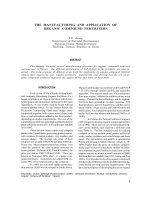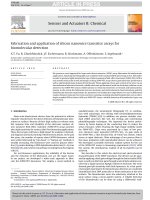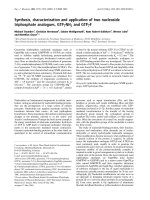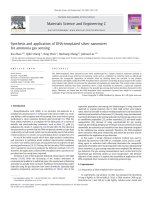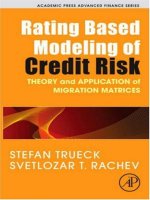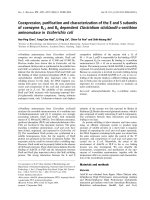Physics Chemistry and Application of Nanostructures-V.E.Borisenko, S.V.Gaponenko, V.S.Gurin
Bạn đang xem bản rút gọn của tài liệu. Xem và tải ngay bản đầy đủ của tài liệu tại đây (27.82 MB, 508 trang )
I
Physics, Chemistry and
Application of Nanostructures
Editors
V. E. Borisenko
S. V. Gaponenko
V. S. Gurin
World Scientific
Physics, Chemistry and
Application of Nanostructures
Reviews and Short Notes to NANOMEETiNG-2001
Physics, Chemistry and
Application of Nanostructures
Reviews a n d Short Notes to NANOMEETING-2001
Minsk, Belarus
22— 25 May 2001
Editors
V. E. Borisenko
Belarusian State University of Informatics and Radioelectronics
S. V. Gaponenko
Institute of Molecular and Atomic Physics
V. S. Gurin
Belarusian State University
V f e World Scientific
wb
London 'Hong Kong
Singapore »New Jersey
Jersey'London*
Published by
World Scientific Publishing Co. Pte. Ltd.
P O Box 128, Farrer Road, Singapore 912805
USA office: Suite IB, 1060 Main Street, River Edge, NJ 07661
UK office: 57 Shelton Street, Covent Garden, London WC2H 9HE
British Library Cataloguing-in-Publication Data
A catalogue record for this book is available from the British Library.
PHYSICS, CHEMISTRY AND APPLICATION OF NANOSTRUCTURES
Reviews and Short Notes to NANOMEETING-2001
Copyright © 2001 by World Scientific Publishing Co. Pte. Ltd.
All rights reserved. This book, or parts thereof, may not be reproduced in any form or by any means,
electronic or mechanical, including photocopying, recording or any information storage and retrieval
system now known or to be invented, without written permission from the Publisher.
For photocopying of material in this volume, please pay a copying fee through the Copyright
Clearance Center, Inc., 222 Rosewood Drive, Danvers, MA 01923, USA. In this case permission to
photocopy is not required from the publisher.
ISBN 981-02-4618-8
Printed in Singapore.
INTERNATIONAL CONFERENCE
NfiNOMEeWQ-2001
Minsk, Belarus, May 22-25, 2001
ORGANIZERS
Belarusian State University of Informatics and Radioelectronics
(Minsk, Belarus)
and
Le Centre de Recherches sur les Mecanismes de la Croissance Cristalline
(Marseille, France)
SPONSORS
European Commission
INTAS
MOTOROLA
Travelink Invest
Ministry of Education of Belarus
Academy of Sciences of Belarus
Basic Research Foundation of Belarus
V
INTERNATIONAL ORGANIZING COMMITTEE
V. E. Borisenko - Co-chairman
F. Arnaud d'Avitaya- Co-chairman
L. J. Balk
E. V. Buzaneva
J. Derrien
S. V. Gaponenko
N. Koguchi
B. W. Licznerski
L. W. Molenkamp
S. Ossicini
K. A. Valiev
(Belarus)
(France)
(Germany)
(Ukraine)
(France)
(Belarus)
(Japan)
(Poland)
(Germany)
(Italy)
(Russia)
BELARUSIAN NATIONAL ORGANIZING COMMITTEE
V. I. Strazhev - Chairman
M. P. Batura
A. I. Belous
V. E. Borisenko
V. S. Gurin
F. F. Komarov
A. A. Leshok
N. M. Olekhnovich
VI
FOREWORD
Dear Reader,
You open the book, which contains invited reviews and short notes of
contributions to NflNOME£lWG-2D01. This Conference is the first international forum of
scientists, studying physics and chemistry of nanostructures, of the XXI-st century.
It is for main objective helping the development of nanotechnology and promoting
nanostructures for applications in modern information and communication
technologies. Impressing results of the last century are summarized in the review
papers while new challenges of the XXI-st century are arising from the other
original contributions. It is evident that even 100 years after the birth of Quantum
Mechanics , we are still learning more and more about interaction between light and
electrons in matter. The Constitution of what, we call "nanoworld", is formed by
quantum effects.
The papers in the book are arranged in traditional sections: Physics of
Nanostructures, Chemistry of Nanostructures, Nanotechnology, and Nanostructure
Based Devices. Both basic and applied researches are presented. Among different
results characterizing our knowledge about the nanoworld, including attempts to use
it for information processing, one can note an increased interest to quantum dot
systems. Depending on the size, composition and spatial distribution of quantum
dots they can behave like artificial atoms, either independent or interacting in a
specific lattice. Such systems exhibit indeed astonishing properties promising the
birth of new generations of electronic, optoelectronic and optical devices.
The papers published in this book must be considered as preprinted notes,
which will be enlightened at the Conference, in May 2001, where a detailed
discussion of our understanding of the nanoworld is expected.
We deeply acknowledge Sponsors who provided financial support for the
Conference.
Victor E. Borisenko
Francois Arnaud d'Avitaya
Co-chairmen of MNOM&MG-IOOI
Minsk and Marseille
January 2001
*14 December 1900, M. Planck presented to the German Physical Society his seminal paper putting
forward radically new idea that the radiated energy can only be emitted in quanta. That day is considered
to be the birth of quantum physics.
VII
CONTENTS
Foreword
vii
PHYSICS OF NANOSTRUCTURES
Discovery and understanding of nanoworld in the XX-th century:
main achievements in the mirror of the Nobel Prizes
3
V. E. Borisenko
Self-assembled InGaAs quantum dot superlattices (invited)
M. Kawabe
15
Multiexciton dynamics of GaAs single quantum dots (invited)
22
K. Edamatsu, C. Watatani, T. Itoh, S. Shimomura, S. Hiyamizu
Photoreflectance Investigations of low dimensional semiconductor
structures (invited)
30
J. Misiewicz, G. Sek, M. Bayer, A. Forchel
Thermoelectric properties of chaotic quantum dots (invited)
40
H. Buhmann, S. Maksimov, L. W. Molenkamp
Polarons in quantum wells (invited)
48
A. I. Bibik, M. O. Dzero, B. Gerlach, M. A. Smondyrev
Self-assembling SiGe dots: nucleation and growth (invited)
57
/. Berbezier, A. Portavoce, F. Volpi, A. Ronda
Stress and strain distributions in Ge dots on Si(001) by molecular
dynamics simulation (invited)
P. Raiteri, F. Valentinotti, L. Miglio
Light emission from semiconducting silicide nanostructures in
silicon (invited)
K. J. Kirkby, M. Lourengo, T. M. Butler, K. Homewood, C. N. Mckinty
IX
69
76
X
Physics of multiwalled carbon nanotubes (invited)
C. Schonenberger, L. Fond
Ultra thin Cfi0-based films: molecular arrangement and electronic
states (invited)
86
94
C. Cepek, M. Sancrotti
On a possibility of the Mott transition in a quantum dot ensemble
A. I. Bibik
102
Screening of extra point charge in a few particle coulomb system
N. A. Poklonski, A. I. Siaglo, S. A. Vyrko, V. V. Mitianok
106
A superlattice with resonant states in a unit cell: the band
structure and electron transitions
110
A. V. Dmitriev, R. Keiper, V. V. Makeyev
Dispersion of guided plasmon-polaritons in a planar Bragg
microresonator with two-dimensional electron system
V. V. Popov, G. M. Thymbalov
114
Optical properties of fractal Cantor-like multilayer nanostructures
118
K. S. Sandomirski, S. V. Gaponenko, S. V. Zhukovsky, A. V. Lavrinenko
I-V curves of short intentionally disordered superlattices in vertical
direction
122
A. V. Dmitriev, O. V. Pupysheva, P. Thomas
Phonon-plasmon interaction in tunneling GaAs/AlAs superlattices:
experiment and calculations
126
M.D.Efremov, V. A. Volodin, V. A. Sachkov, V. V. Preobrazhenskii,
B. R. Semyagin, E. A. Galaktionov
Negative and persistent positive photoconductivity in p-type
AI 05 Ga 05 As/GaAs/Al 05 Ga 05 As
E. V. Bogdanov, A. A. Ilievsky, N. Ya. Minina, A. M. Savin,
O. P. Hansen, C. B. Sorensen, W. Kraak
130
XI
Raman and photoluminescence studies of the interface reconstructions
in GaAs/AlAs superlattices grown on (311) and (001) surfaces
134
M. D. Efremov, V. A. Volodin, V. A. Sachkov, V. V. Preobrazhenskii,
B. R. Semyagin, E. A. Galaktionov, A. V. Kretinin
Investigation of surface morphology features and local photoelectric
properties of InAs/GaAs quantum dot structures
138
V. Ya. Aleshkin, A. V. Biryukov, N. V. Vostokov, S. V. Gaponov,
V. M. Danil 'tsev, V. L. Mironov, A. V. Murel, O. I. Khrykin,
V.I.Shashkin
Controllable one-dimensional photonic structures with n-i-p-i crystal
layers
142
V. N. Gusyatnikov, I. S. Nefedov, Yu. A. Morozov, V. K. Kononenko,
D. V. Ushakov
Influence of electron irradiation on carrier recombination and intradot
relaxation in InGaAs/GaAs quantum dot structures
146
N. A. Sobolev, A. Cavaco, M. C. Carmo, H. Born, M. Grundmann,
F. Heinrichsdorff, R. Heitz, A. Hoffmann, D. Bimberg
Electric field effect on absorption spectra of an ensemble of
close-packed CdSe nanocrystals
150
L. I. Gurinovich, M. V. Artemyev, U. Woggon
Ge nanocrystals in SiC: ab initio supercell calculations of optical
properties
156
H.-Ch. Weissker, J. Furthmuller, F. Bechstedt
Surface energies of Ge and Si and consequences for
nanocrystallites
160
A. A. Stekolnikov, J. Furthmuller, R Kdckell, F. Bechstedt
2D nanostructures and 3D silicide nanocrystallites at rare-earth
metal/Si(lll) interfaces: formation mechanism and properties
T. V. Krachino, M. V. Kuz 'min, M. V. Loginov, M. A. Mittsev
164
xii
Photoluminescence of the silicon carbide nanoclusters embeded into
porous silicon
168
A. G. Rozhin, N. I. Klyui, V. G. Litovchenko, Yu. P. Piryatinskii,
V.A. Makara, O. B. Korneta
Exciton recombination mechanism in light emitting nanocrystalline
silicon
172
A. V. Sachenko, E. B. Kaganovich, E. G. Manoilov
Time-resolved photoluminescence of nanocrystalline silicon films
obtained by laser ablation
176
E. B. Kaganovich, E. G. Manoilov, A. V. Sachenko, S. V. Svechnikov
Electron-phonon coupling in heavily doped silicon
180
P. Kivinen, A. Savin, A. Manninen, J. Pekola, M. Prunnila,
J. A hope!to
Influence of surface phases on electrical conductivity of
silicon surface
184
D. A. Tsukanov, S. V. Ryzhkov, O. A. Utas, J. A. Belous, V. G. Lifshits
Morphology and optical properties of Si(lll)/CrSi 2 /Si and
Si(lll)/Mg 2 Si/Si systems with self-organized quantum dots
N. G. Galkin, A. M. Maslov, S. I. Kosikov, A. O. Talanov,
K. N. Galkin
Microcavity enhancement of second-harmonic generation and Raman
scattering in photonic crystals of porous silicon
M. G. Martemyanov, T. V. Dolgova, A. I. MaYdikovskll,
A. A. Fedyanin, O. A. Aktsipetrov, D. Schuhmacher, G. Marowsky,
V.A. Yakovlev, G. Mattei
Structural and electrical characterization of thin crystalline CaF2
layers grown by MBE on Si(lll)
190
194
198
G. Guirleo, F. Bassani
Switching effect in lead phthalocyanine nanostructure
N. A. Poklonski, E. F. Kislyakov, G. G. Fedoruk,
D. I. Sagaidak, A. I. Siaglo, S. A. Vyrko
202
XIII
Photoreflectance diagnostics of nanometer dielectric films
206
P. Adams on
Nanostructured Ti0 2 :Tb 2 0 3 phosphor fabricated by sol-gel method
on porous anodic alumina
O. V. Sergeev, V. E. Borisenko, R. Heiderhoff, L. J. Balk
210
Three-dimensional photonic band gap structures doped with Tb3+ ions.... 214
N. V. Gaponenko, V. M. Shelekhina, O. A. Prokhorov, P. A. Vityaz,
A. P. Stupak, A. N. Ponyavina, S. V. Gaponenko, J. C. Pivin,
A. V. Mudryi
Europium photoluminescence in sol-gel derived titania xerogel on
porous anodic alumina
221
/. S. Molchan, V. I. Pachinin, J. Misiewicz, R. Kudrawiec,
G. E. Thompson, P. Skeldon, L. P. Mileshko
Dynamic observation and structure analysis of nanostructures of Cu
on Si(lll) by low energy electron microscopy
225
T. Koshikawa, T. Yasue, M. Jalochowski, E. Bauer
Optical properties of layer-periodic metal nanoparticle systems in
the visible
235
S. M. Kachan, A. N. Ponyavina
Conductance quantization in magnetic and nonmagnetic metallic
nanowires
239
W. Nawrocki, M. Wawrzyniak
Conductivity of two-dimensional chromium and iron ordered surface
phases on Si(lll)
N. G. Galkin, D. L. Goroshko, S. Ts. Krivoshchapov
Effect of the symmetry on the properties of superconductor/normal
metal nanostructures
V. N. Kushnir, A. Yu. Petrov, S. L. Prischepa, A. Angrisani Armenio,
C. Attanasio, L. Maritato
243
247
XIV
CHEMISTRY OF NANOSTRUCTURES
Self-assembling alkali nanowires at semiconductor surfaces (invited)
Maria Grazia Betti
Relaxation processes in self-assembled nanoscale photosynthetic
models (invited)
255
263
E. I. Zenkevich, A. M. Shulga, C. von Borczyskowski
Electronic processes in nanocomposite films (invited)
R. D. Fedorovich, O. E. Kiyayev, A. G. Naumovets,
P. M. Tomchuk
Size-control of small metal clusters and nanoparticles in zeolites: silver
and copper in mordenites with variable Si0 2 /Al 2 0 3 molar ratio
V. S. Gurin, N. E. Bogdanchikova, V. P. Petranovskii
Formation of ultradisperse bimetallic particles by redox processes
in aqueous solutions
273
281
287
Yu. A. Fedutik, Yu. V. Bokshits, G. P. Shevchenko
Polyelectrolyte micro- and nanocapsules as microcages for chemical
reactions in restricted volumes
291
G. B. Sukhorukov, I. L. Radtchenko, H. Mohwald
Employment of the layer-by-layer technique for the formation
of polymer-core Ti02-shell particles and Ti02 hollow spheres
295
A. S. Susha, N. A. Shkorik, R. A. Caruso, F. Caruso
Observation of single molecule diffusion in micro- and nanodroplets
of polymers on surfaces
299
J. Schuster, F. Cichos, C. von Borczyskowski, J. Wrachtrup
Chemically grown II-VI semiconductor quantum dots for
optoelectronic and photonic applications
N. P. Gaponik, D. V. Talapin, S. K. Poznyak, A. S. Susha,
A. L. Rogach, A. Eychmiiller
304
XV
Fast electrochemical impedance spectroscopy for nanochemistry and
nanophysics
G. A. Ragoisha, A. S. Bondarenko
Kinetics of tip induced oxidation by scanning probe microscope
S. A. Gavrilov, S. V. Lemeshko, V. I. Shevyakov, V. M. Roschin
Features of luminescent semiconductor nanowire array formation
by electrodeposition into porous alumina
308
313
317
S. A. Gavrilov, D. A. Kravtchenko, A. I. Belogorokhov, E. A. Zhukov,
L. I. Belogorokhova
Structural, electrical and gas sensing properties of copper
phthalocyanine nanoparticles in polystyrene
321
A. V. Misevich, A. E. Pochtenny, I. P. Ilyushonok, O. M. Stukalov
NANOTECHNOLOGY
Micro- and nanostructures: preparation and applications (invited)
R. Kassing
329
Massively parallel atomic lines on silicon carbide (invited)
340
P. Soukiassian
Formation of silicon and germanium nanostructures using
ultrathin Si0 2 films (invited)
353
M. Ichikawa
High temperature superconducting artificial superlattices:
technology and perspectives (invited)
L. Maritato
Semi-spherical SiGe/Si-nanostructures grown by MBE with in situ
ion-beam assistance
P. I. Gaiduk, J. Lundsgaard Hansen, A. Nylandsted Larsen
364
372
XVI
Molecular beam epitaxial growth and photoluminescence
studies of InAs self-organized quantum dots on patterned
GaAs (001) substrates
376
B. C. Lee, H. M. Lee, J. C. Wu, Y. P. Chang, K. W. Sun, C. P. Lee
Production type planetary® MOVPE reactors for fabrication of
nitride quantum well lasers
381
B. Schineller, H. Protzmann, M. Luenenbuerger, M. Heuken,
E. V. Lutsenko, G. P. Yablonskii
SPM modification of organic Langmuir-Blodgett films
386
L. V. Kukharenko, V. G. Leschenko, G. Y. Akulov, V. M. Anishchik,
V. V. Grushevski, G. V. Krylova, A. I. Khmelnitski
Advancing magnetic force microscopy
390
/. Fedorov, V. Shevyakov, P. Prikhodko
Microporous xerogels in mesoporous anodic alumina
393
N. V. Gaponenko
Technology of pillar microstructure formation with anodic oxides
399
A. I. Vorobyova, E. A. Outkina
New materials and nanostructures for organic electroluminescent
devices
403
A. V. Kukhta, E. E. Kolesnik
Cadmium seienide nanocrystals inside plastic microspheres: a quantum
dot in a photonic dot structure with unusual optical properties
408
M. V. Artemyev
Porous silicon as a material for enhancement of electron
field emission
A. A. Evtukh, V. G. Litovchenko, Yu. M. Litvin, A. A. Efremov,
Yu. V. Rassamakin, A. V. Sarikov, D. V. Fedin
On use of Bessel light beams in nanotechnologies
N. S. Kazak, A. A. Ryzhevich, A. N. Khilo
412
417
XVII
Computer simulation of gas-phase plasma chemistry and silicon ion
cluster formation during PECVD
A. F Stekolnikov, D. V. Feshchenko, T. A. Metelskiy, R. F. Belich
Development and application of nanostructured metallized fiber
materials in microwave absorbers
424
428
V. Bogush, V. Glybin, L. Lynkov
NANOSTRUCTURE BASED DEVICES
Carrier transport and electroluminescence in Si/CaF2
superlattices (invited)
433
V. Ioannou-Sougleridis, A. G. Nassiopoulou, T. Ouisse, F. Bassani,
F. Arnaud d'Avitaya
Reverse biased porous silicon light emitting diodes for
optoelectronics (invited)
441
S. K. Lazarouk
Energy transfer and lasing in InGaN/GaN multiple quantum well
heterostructures
450
G. P. Yablonskii, A. V. Mudryi, E. V. Lutsenko, V. N. Pavhvskii,
I. P. Marko, V. Z Zubialevich, B. Schineller, H. Protzmann,
M. Luenenbuerger, M. Heuken
A new multipeak resonant tunneling diode for signal processing
application
454
A. N. Kholod, M. Liniger, A. Zaslavsky, A. L. Danilyuk,
F. Arnaud d'Avitaya
A cyclotron resonance quantum Hall effect detector
B. A. Andreev, I. V. Erofeeva, V. I. Gavrilenko, A. L. Korotkov,
A. N. Yablonskiy, O. Astafiev, Y. Kawano, R. S. Komiyama
The role of shallow and deep traps in carrier transport across
silicon/insulator nanostructures
J. A. Berashevich, A. L. Danilyuk
459
463
xviii
Long term charge relaxation in silicon single electron transistors
A. Savin, A. Manninen, P. Kivinen, J. Pekola, M. Prunnila,
J. Ahopelto, M. Kamp, M. Emmerling, A. Forchel
466
Intersubband electron scattering rates in one-dimensional Si
MOS-structure
V. M. Borzdov, V. O. Galenchik, O. G. Zhevnyak, F. F. Komarov
470
The potential of (3-FeSi2 nanostructures for solar cell applications
473
C. N. Mckinty, K. J. Kirkby, K. P. Homewood, S.-P. Edwards, G Shao,
R. Valizadeh, J. S. Colligon
Resonant tunneling through an array of quantum dots coupled to
superconductors under the effect of magnetic field
476
A. N. Mina
Modeling of the differential conductance of mesoscopic system:
theory and simulation
480
A. H. Aly
Author index
485
PHYSICS OF NANOSTRUCTURES
PHYSICS, CHEMISTRY AND APPLICATION OF NANOSTRUCTURES, 2001
DISCOVERY AND UNDERSTANDING OF NANOWORLD IN THE XX-th
CENTURY: MAIN ACHIEVEMENTS IN THE MIRROR OF THE NOBEL
PRIZES
V. E. BORISENKO
Belarusian State University of Informatics and Radioelectronics
P.Browka 6, 220013 Minsk, Belarus
E-mail: borisenko@nano. bsuir. edu. by
A historical survey of main contributions made possible to understand phenomena in
nanoworld, which is the world spreading from individual atoms to low-dimensional
structures, is composed on the basis of the achievements awarded the Nobel Prizes.
The XX-th century has written the most impressive pages in the book of
understanding of nature. That century was illuminated by discoveries and studies of
quantum phenomena that were completely unknown. Revolutionary new ideas on
the theoretical basis of quantum physics were formulated, thus providing
development of novel technologies, tools and devices. They have covered not only
physics, but also chemistry, biology, medicine and their related applied areas.
Electrons and light have been recognized to behave as particles and waves
simultaneously. It is indeed pronounced in systems having at least one dimension in
the nanometre (1 nm = 10"9 m) range. The term "nanoworld" appeared in the end of
the XX-th century in order to represent such systems and particular phenomena
there. In fact, the nanoworld spreads from individual atoms and molecules to their
ensembles and low-dimensional structures which behavior is regulated by
quantum-wave nature of electrons and photons. Nanoworld is considered to have
the greatest potential for a progress in information technologies in the XXI-st
century.
Main contributors and their discoveries providing understanding of nanoworld
[1-6] are listed below in the chronological order they were recognized by the Nobel
Foundation. The Nobel Prize institution has been chosen as a mirror for that, as far
as the prizes cover many of the outstanding contributions to physics and chemistry,
while a complete historical survey would definitely need an extension of the list of
names and phenomena.
1902 (physics): Hendrik Antoon Lorentz (Leiden University, The
Netherlands) and PieterZeeman (Amsterdam University, The Netherlands) - in
recognition of the extraordinary service they rendered by their researches into the
influence of magnetism upon radiation phenomena.
The mechanisms of light emission by carriers of electric charge was studied by
H. A. Lorentz, who was one of the first to apply Maxwell's equations to electric
3
4
charges in matter. His theory could also be applied to the radiation caused by
vibrations in atoms.
As early as 1896, P. Zeeman, who was looking for possible effects of electric
and magnetic fields on light, made an important discovery, namely, that spectral
lines from sodium in a flame were split up into several components when a strong
magneticfieldwas applied.
1906 (physics): Sir Joseph John Thomson (Cambridge University, GB) - in
recognition of the great merits of his theoretical and experimental investigations on
the conduction of electricity by gases.
In 1897, J. J. Thomson, who worked with rays emanating from the cathode in
partly evacuated discharge tubes, identified the carriers of electric charge [7]. He
showed that these rays consisted of discrete particles, later called "electrons". He
measured a value for the ratio between their mass and (negative) charge, and found
that it was only a very small fraction of that expected for singly charged atoms. It
was soon realized that these lightweight particles must be the building blocks that,
together with the positively charged nuclei, make up all different kinds of atoms.
1913 (physics): Heike Kamerlingh-Onnes (Leiden University, The
Netherlands) - for his investigations on the properties of matter at low temperatures
which led, inter alia, to the production of liquid helium.
In 1911, H. Kamerlingh-Onnes discovered superconductivity. He noticed that
the electrical resistivity of mercury dropped to less than one billionth of its ordinary
value when it was cooled well below a transition temperature, which is about 4 K
[8].
1918 (physics):
Max Karl Ernst Ludwig Planck
(Berlin
University,
Germany) - in recognition of the services he rendered to the advancement of
Physics by his discovery of energy quanta.
In December 1900, M. Planck presented to the German Physical Society his
seminal paper putting forward radically new idea that the radiated energy can only
be emitted in quanta, i.e. portions that have a certain definite value, larger for the
short wavelengths than for the long ones (equal to a constant times the frequency
for each quantum) [9]. December 1900 is considered to be the birth of quantum
physics.
1919 (physics): Johannes Stark (Greifswald University, Germany) - for his
discovery of the Doppler effect in canal rays and the splitting of spectral lines in
electric fields.
In 1907, J. Stark demonstrated the direct effect of electric fields on the
emission of light, by exposing beams of atoms ("anodic rays", consisting of atoms
or molecules) to strong electric fields [10]. He observed a complicated splitting of
spectral lines as well as a Doppler shift depending on the velocities of the emitters.
1921 (physics): Albert Einstein (Kaiser-Wilhelm-Institut fur Physik, now
Max-Planck-Institute, Berlin-Dahlem, Germany) - for his services to Theoretical
Physics, and especially for his discovery of the law of the photoelectric effect.
5
In 1904-1905, A. Einsten interpreted the photoelectric effect (first observed in
1887 by Hertz) and extended Planck's theory of black-body radiation in terms of
energy quanta [11]. In 1905 he presented his special theory of relativity, which
expressed the mass-energy relationship. He also made important contributions to the
quantum theory of the specific heats of solids (1907) and to energy fluctuations
(1909).
1922 (physics): Niels Henrik David Bohr (Copenhagen University, Denmark)
- for his services in the investigation of the structure of atoms and of the radiation
emanating from them.
In 1913, N. Bohr worked out a planetary picture of electrons circulating around
the nucleus of an atom [12]. Later (1914-1915) he found that the sharp spectral lines
emitted by the atoms could only be explained if the electrons were circulating in
stationary orbits characterized by a quantized angular momentum and that the
emitted frequencies corresponded to emission of radiation with energy equal to the
difference between quantized energy states of the electrons [13].
1923 (physics): Robert Andrews Millikan (California Institute of Technology,
Pasadena, USA) - for his work on the elementary charge of electricity and on the
photoelectric effect.
In 1912, R. A. Millikan made the first precision measurements of the electron
charge with the oil-drop method [14] and contributed to the quantum description of
the photoelectric effect [15].
1929 (physics): Prince Louis-Victor Pierre Raymond de Brogiie (Sorbonne
University, Institut Henri Poincard, Paris, France) - for his discovery of the wave
nature of electrons.
In 1923, L. de Brogiie proposed that material particles may also show wave
properties, now that electromagnetic radiation had been shown to display particle
aspects in the form of photons [16]. He developed mathematical expressions for this
dualistic behavior, including what has later been called the "de Brogiie wavelength"
of a moving particle.
1930 (physics): Sir Chandrasekhara Venkata Raman (Calcutta University,
India) - for his work on the scattering of light and for the discovery of the effect
named after him.
In 1928, C. V. Raman discovered that light scattered from molecules contained
components which were shifted in frequency with respect to the infalling
monochromatic light [17]. These shifts are caused by the molecules' gain or loss of
characteristic amounts of energy when they change their rotational or vibrational
motion. The effect was also independently observed by Russian scientists
G. Landsberg and L. Mandelstam in St. Petersburg [18]. Raman spectroscopy soon
became an important source of information on molecular structure and dynamics.
1932 (physics): Werner Karl Heisenberg (Leipzig University, Germany) - for
the creation of quantum mechanics, the application of which has, inter alia, led to
the discovery of the allotropic forms of hydrogen.
6
In the late 1920s, W. K. Heisenberg developed a mathematically different
approach in quantum mechanics, called "matrix mechanics". He arrived to the
conclusion that there are natural limitations on the accuracy by which certain
quantities can be measured simultaneously (Heisenberg's uncertainty relations) [19].
1932 (chemistry): Irving Langmuir (General Electric Company, Schenectady,
USA) - for his discoveries and investigations in surface chemistry.
In 1916-1918, I. Langmuir discovered importance of chemical events at an
interface of two phases (for example, solid and liquid) [20] and showed that
phenomena at such interfaces have important applications all the way from
technical to physiological processes. He was the first industrial scientist to receive
the Nobel Prize.
1933 (physics): Erwin Schrodinger (Berlin University, Germany) and Paul
Adrien Maurice Dirac (Cambridge University, GB) - for the discovery of new
productive forms of atomic theory.
In 1926, E. SchrOdinger further developed wave ideas of de Broglie in quantum
mechanics and created what has been called "wave mechanics" [21]. In 1925-1926,
P. A. M. Dirac constructed a modified formalism which took into account effects of
Einstein's special relativity [22], and showed that such a theory not only contained
terms corresponding to the intrinsic spinning of electrons (and therefore explaining
their own intrinsic magnetic moment and the fine structure observed in atomic
spectra), but also predicted the existence of a completely new kind of particles, the
so-called antiparticles with identical masses but opposite charge. The first
antiparticle to be discovered, that of the electron, was observed in 1932 by
C. D. Anderson and was given the name "positron" (one half of the Physics Prize
for 1936).
1936 (chemistry): Petrus Josephus Wilhelmus Debye (Berlin University,
Germany) - for his contributions to our knowledge of molecular structure through
his investigations on dipole moments and on the diffraction of X-rays and electrons
in gases.
In 1916-1923, P. Debye employed electron diffraction and the measurement of
dipole moments to get structural information [23]. Dipole moments are found in
molecules, in which the positive and negative charge is unevenly distributed (polar
molecules).
1937 (physics): Clinton Joseph Davisson (Bell Telephone Laboratories, New
York, USA) and George Paget Thomson (London University, GB) - for their
experimental discovery of the diffraction of electrons by crystals.
In 1923, C. J. Davisson and C. H. Kunsman indicated that electrons could
actually show reflection effects similar to that of waves hitting a crystal [24] and
these experiments were now repeated, verifying the associated wavelength
predicted by de Broglie. Somewhat later (1927), G. P. Thomson (son of
J. J. Thomson) and A. Reid made much improved experiments on higher energy
electrons penetrating thin metal foils, which showed very clear diffraction effects
[25].



